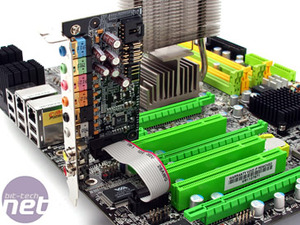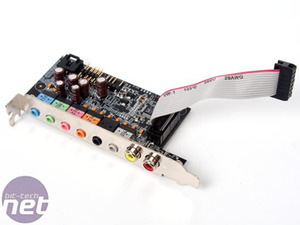There’s plenty of space between the PCI-Express slots for graphics breathing room, and you can still use the bottom x16 slot (x4 electrical) if you want to use an x1 device.
However, because the south bridge only has six PCI-Express connections out of it, when using the x4 at x4 bandwidth, the PCI-Express x1 and second Gigabit Ethernet are disabled. While at first we thought “that's crazy! You're losing features!,” sitting down to think about it, DFI has just offered more features given the inherent limitations of the Intel chipset.
Although, perhaps DFI should have used a PCI-based Gigabit Ethernet for the second connection, but then the performance would be worse – you simply can't win, I guess.
The pin-outs are all pretty well placed, although because DFI has included this extra bottom slot it has pushed the USB pin-outs into the board a little instead of having them sitting along the bottom edge.
Frustratingly, DFI also still insists on using floppy connectors instead of Molex for the additional PCI-Express power. We really wish it’d stop doing this as they are not only easily confused with 4-pin fan connectors, but they’re placed right across the other side of the board on the inside edge, making them difficult to get to.
What DFI does do right is include the little enthusiast touches like the two digit LED POST readout and onboard power and reset buttons, but sadly there’s no clear CMOS button which is just as useful, if not more.
It’s powered by the premium Realtek ALC885 codec which is advertised to feature “content protection” for Blu-ray or HD DVD audio, although it entirely depends on the software you’re using.
The advantage of a daughterboard is that it reduces noise and it comes on a flexible cable rather than hard-clipping plug so it can be moved to whatever PCI bracket space is best suited – this is far more convenient.
However, because the south bridge only has six PCI-Express connections out of it, when using the x4 at x4 bandwidth, the PCI-Express x1 and second Gigabit Ethernet are disabled. While at first we thought “that's crazy! You're losing features!,” sitting down to think about it, DFI has just offered more features given the inherent limitations of the Intel chipset.
Although, perhaps DFI should have used a PCI-based Gigabit Ethernet for the second connection, but then the performance would be worse – you simply can't win, I guess.
The pin-outs are all pretty well placed, although because DFI has included this extra bottom slot it has pushed the USB pin-outs into the board a little instead of having them sitting along the bottom edge.
Frustratingly, DFI also still insists on using floppy connectors instead of Molex for the additional PCI-Express power. We really wish it’d stop doing this as they are not only easily confused with 4-pin fan connectors, but they’re placed right across the other side of the board on the inside edge, making them difficult to get to.
What DFI does do right is include the little enthusiast touches like the two digit LED POST readout and onboard power and reset buttons, but sadly there’s no clear CMOS button which is just as useful, if not more.
Rear I/O
- PS2 mouse and keyboard
- Six USB 2.0 ports
- One 6-pin Firewire port
- Two RJ45 Gigabit Ethernet ports
It’s powered by the premium Realtek ALC885 codec which is advertised to feature “content protection” for Blu-ray or HD DVD audio, although it entirely depends on the software you’re using.
The advantage of a daughterboard is that it reduces noise and it comes on a flexible cable rather than hard-clipping plug so it can be moved to whatever PCI bracket space is best suited – this is far more convenient.

MSI MPG Velox 100R Chassis Review
October 14 2021 | 15:04














Want to comment? Please log in.